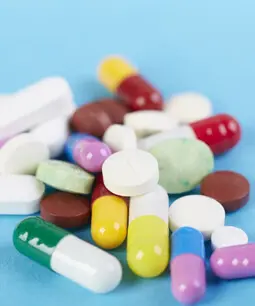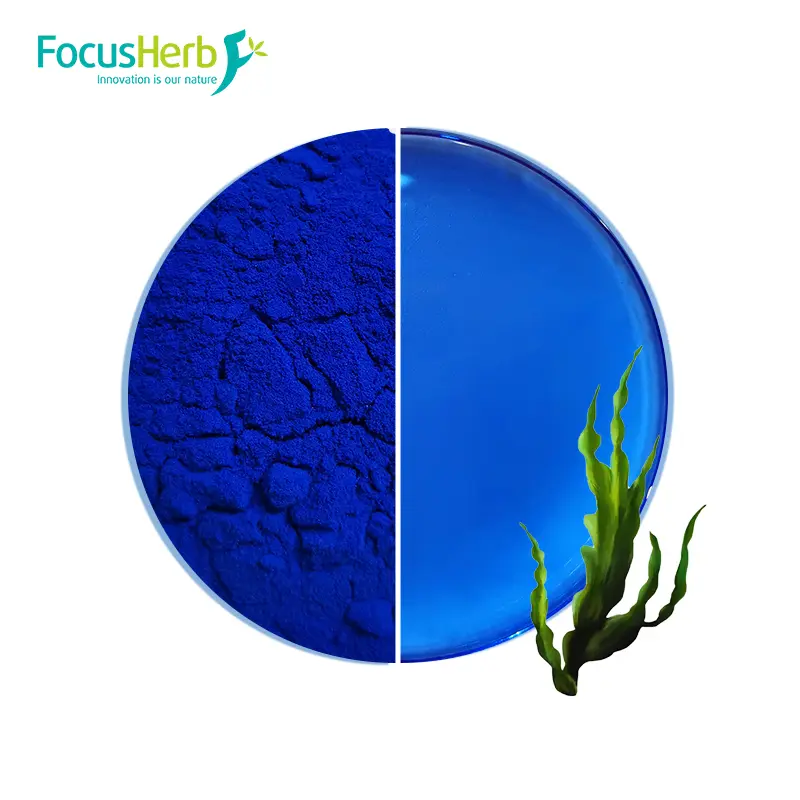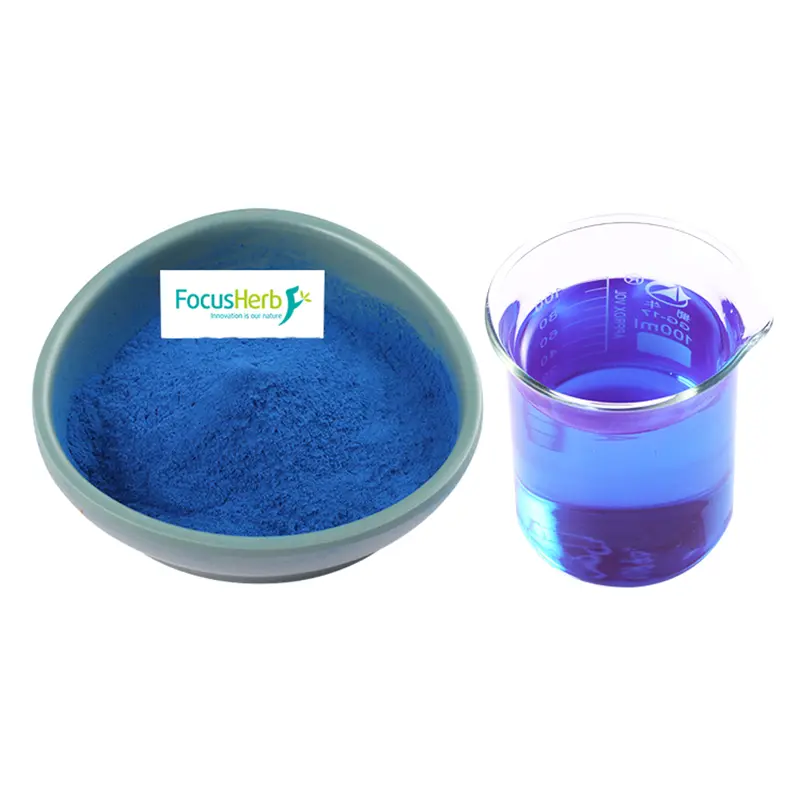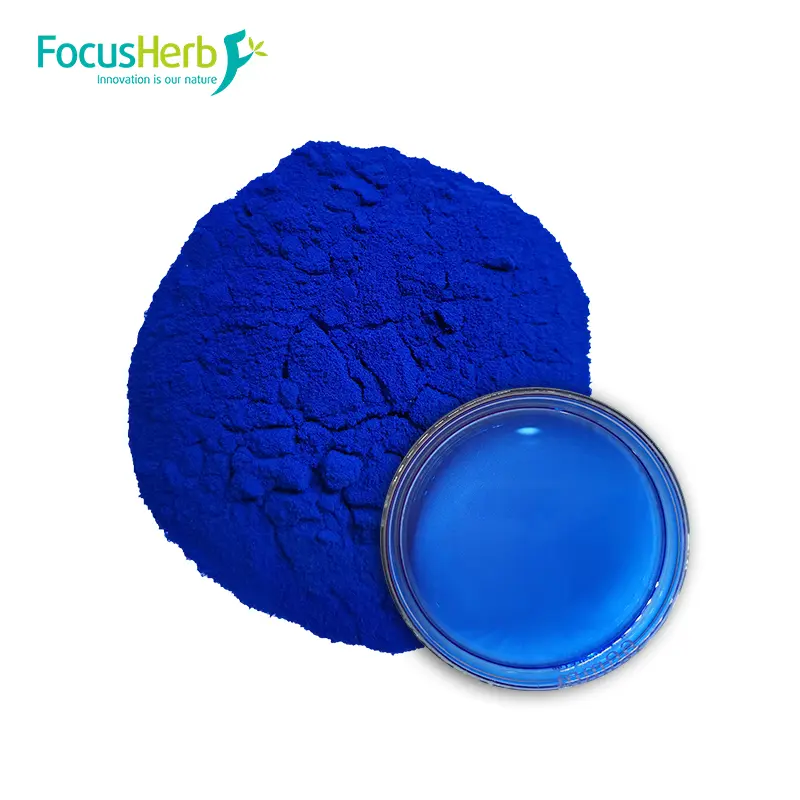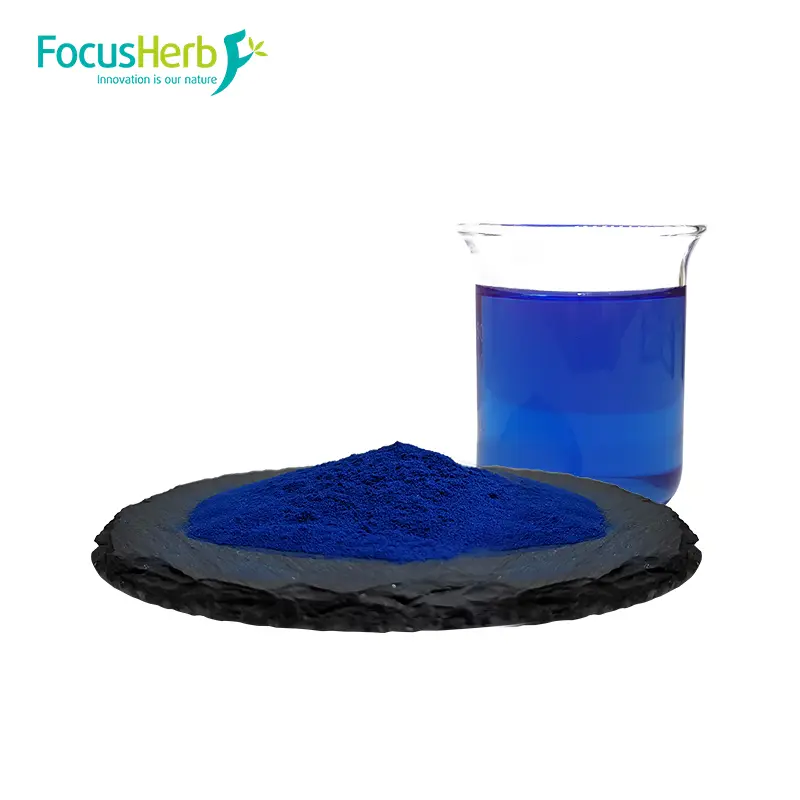Phycocyanin, a unique and captivating color in nature’s palette, stands out from algae like Spirulina and Arthrospira. Its deep, pure blue color makes it a leader among natural pigments. It not only adds vibrant color to our world but also possesses rich nutritional value and broad application potential.
Phycocyanin, a natural pigment extracted from algae such as cyanobacteria, red algae, and cryptophytes, appears as a deep blue powder. It is a protein-bound pigment and, therefore, exhibits properties similar to proteins, with an isoelectric point of 3.4. It is soluble in water but insoluble in alcohol and oil. It is relatively stable in weakly acidic and neutral environments (pH 4.5-8), but precipitates in highly acidic environments (pH 4.2) and discolors in the presence of strong bases. Its unique chemical structure makes it potentially applicable in a wide range of applications, including food, medicine, and cosmetics.
In nature, phycocyanin is primarily found in algae such as cyanobacteria, red algae, and cryptophytes. Phycocyanin plays a crucial role within the cells of these algae. As an accessory pigment in photosynthesis, it absorbs orange-yellow light and transfers that energy to chlorophyll, contributing to photosynthesis and playing an indispensable role in algal growth, development, and reproduction. For example, the abundant phycocyanin content in spirulina gives it its distinctive blue-green color. It is precisely because of this phycocyanin that spirulina is able to efficiently utilize light energy for photosynthesis and sustain its life.
Properties Revealed: Unique Properties Demonstrate Advantages
Physical Properties
Phycocyanin appears as a fine, uniform, deep blue powder. When dissolved in water, it forms a clear, vibrant blue solution. This shade of blue, reminiscent of the deep ocean and the clear sky, creates a sense of tranquility and profoundness. Its aqueous solution also exhibits a faint red fluorescence under certain wavelengths of light, adding a touch of mystery to the color. It has excellent solubility, readily soluble in water but insoluble in alcohol and oil. This property allows it to function effectively in aqueous systems, imparting a distinctive blue color to products such as foods and beverages.
Chemical Properties
From a chemical perspective, phycocyanin is composed of an apoprotein tightly bound to phycocyanin via a thioether bond. This unique structure endows it with numerous biological functions. In terms of stability, phycocyanin is relatively stable in weakly acidic and neutral environments (pH 4.5-8), maintaining its structural and functional integrity. However, in more acidic environments (pH 4.2), it precipitates. This is because the charge distribution of the protein changes under acidic conditions, leading to enhanced intermolecular interactions and aggregation and precipitation. Phycocyanin decolorizes when exposed to strong bases, which destroy the chromophores in its molecular structure, causing it to lose its original blue color. Phycocyanin also exhibits some instability under the influence of light and temperature. Prolonged exposure to light or high temperatures accelerates its degradation, causing its color to gradually fade and its biological activity to decrease.
Extraction Process: The Transformation from Algae to Essence
Traditional Extraction Methods
Traditional phycocyanin extraction methods, like a time-honored skill, have evolved and improved over the course of history, providing the foundation for obtaining this natural pigment.
Freeze-thaw cycles are a common traditional method. This method utilizes drastic temperature fluctuations to cause the water within algae cells to freeze and expand, disrupting the cell structure and releasing phycocyanin. In practice, algae samples containing phycocyanin are frozen to a low temperature, such as -20°C, and then thawed to room temperature repeatedly, typically three to five times. This method has the advantages of being relatively simple, requiring no specialized equipment, and being relatively cost-effective. However, its disadvantages are also significant: extraction efficiency is relatively low, the process is time-consuming, and the phycocyanin may be damaged to some extent during the freeze-thaw cycle, resulting in reduced biological activity.
Water extraction uses water as a solvent to dissolve phycocyanin from algae. The specific steps involve mixing the algae raw material with an appropriate amount of water, stirring or shaking at a certain temperature for a period of time to fully dissolve the phycocyanin in the water, and then separating the supernatant by centrifugation or filtration to obtain a crude extract containing phycocyanin. This method has the advantages of being safe, environmentally friendly, low-cost, and not introducing any other chemicals. However, it also has some disadvantages, such as long extraction time, relatively low extraction yield, and high impurities in the crude extract, requiring further purification.
The buffer method uses a specific buffer solution to extract phycocyanin. By adjusting the pH and ionic strength of the buffer, a suitable environment is created to promote the dissolution and release of phycocyanin. Commonly used buffers include phosphate buffer and Tris-HCl buffer. Compared with aqueous extraction, the buffer method can better maintain the stability of phycocyanin, improve extraction yield, and enhance purity. However, this method requires a certain amount of chemical reagents to prepare the buffer, which increases costs and the subsequent purification process is more complicated.
Modern Innovative Technologies
With the rapid advancement of science and technology, modern innovative technologies have brought new breakthroughs and revolutions to the extraction of phycocyanin, enabling us to obtain this precious natural pigment more efficiently and with higher quality.
Membrane separation technology, a separation method based on the principle of membrane selective permeability, plays an important role in the extraction of phycocyanin. Ultrafiltration membranes can separate phycocyanin from other impurities based on molecular size, retaining larger phycocyanin molecules while allowing smaller molecules and solvents to pass through. Nanofiltration membranes can further remove even smaller impurities and ions, thereby improving the purity of phycocyanin. The advantages of this technology include simple operation, low energy consumption, and no phase transition. It can be performed at room temperature, effectively avoiding the degradation of phycocyanin at high temperatures and maximizing its biological activity. Furthermore, membrane separation technology allows for continuous production, improving efficiency. However, membranes are expensive and prone to fouling during use, requiring regular cleaning and replacement, increasing production costs and maintenance complexity. Supercritical fluid extraction (SCFE) utilizes the exceptional solubility of supercritical fluids under specific conditions to extract phycocyanin. Carbon dioxide is a commonly used supercritical fluid. In its supercritical state, SCFE combines the advantages of a gas’s low viscosity and high diffusivity with the high density and strong solubility of a liquid. When SCFE comes into contact with algae, it rapidly penetrates the cells, dissolving the phycocyanin. The phycocyanin is then separated from the supercritical fluid by adjusting the temperature and pressure. This technique offers advantages such as high extraction efficiency and speed, and can be performed at relatively low temperatures, minimizing oxidation and degradation of the phycocyanin. Furthermore, SCFE is non-toxic, odorless, non-flammable, inexpensive, and environmentally friendly. However, SCFE requires specialized equipment, high investment costs, demanding operating conditions, and a high level of technical expertise.
Application Areas: The Multifaceted Miraculous Protein
Food Industry
In the food industry, phycocyanin is like a magical wizard, bringing unique colors and rich nutrition to a wide range of foods. It is an ideal natural food coloring, its pure blue color adding a refreshing and unique visual appeal to foods. Whether in beverages, dairy products, candies, or baked goods, phycocyanin can perform its excellent coloring function, satisfying consumers’ pursuit of aesthetically pleasing food. For example, some high-end ice cream brands cleverly use phycocyanin to impart a dreamy blue color, making it stand out from the crowd and attracting the attention of many consumers. Adding phycocyanin to juice drinks not only imparts a unique blue color but also blends with the color of the juice itself, creating novel and attractive color combinations that stimulate consumer purchases.
Phycocyanin also has nutritional benefits. Rich in essential amino acids, it is a high-quality source of protein, providing a rich nutritional base. Phycocyanin is used as a key nutrient in functional foods, such as sports nutrition products and children’s nutritional supplements. In sports nutrition products, phycocyanin can help athletes replenish protein lost after exercise and promote muscle repair and growth. In children’s nutritional supplements, phycocyanin can provide essential nutritional support for children’s growth and development, contributing to their healthy development.
Healthcare
In the healthcare field, phycocyanin has demonstrated tremendous potential, attracting the attention of numerous researchers like a shining star. Research has shown that phycocyanin possesses a variety of pharmacological activities and offers numerous benefits to human health.
Antioxidant properties are one of phycocyanin’s key properties. During human metabolism, a large number of free radicals are produced. These free radicals attack cells, causing cell damage and aging, which in turn can lead to various chronic diseases. Phycocyanin acts as a guardian, efficiently scavenging free radicals such as superoxide anions, hydrogen peroxide, and hydroxyl radicals in the body, reducing the damage caused by oxidative stress to cells. It also regulates the levels of antioxidant enzymes in the body, such as superoxide dismutase (SOD) and glutathione peroxidase (GSH-Px), further strengthening the body’s antioxidant defense system, thereby slowing the aging process and preventing the onset of chronic diseases such as cardiovascular disease and cancer.
Phycocyanin’s anti-cancer effects have also attracted considerable attention. Numerous experiments have shown that it can inhibit the growth and spread of various cancer cells, including lung, liver, and colon cancer. Phycocyanin primarily exerts its anti-cancer effects through the following mechanisms: inhibiting DNA synthesis and cell division in cancer cells, arresting them in the G0/G1 phase and preventing further proliferation; activating apoptosis, prompting cancer cell self-destruction and reducing tumor size; inhibiting the expression of tumor angiogenesis factors, thereby cutting off the tumor’s nutrient supply and preventing it from thriving; and stimulating the immune system, increasing the activity of lymphocytes and macrophages, and enhancing the body’s ability to kill cancer cells.
Phycocyanin also has significant anti-inflammatory properties. Inflammation is the body’s defensive response to external stimuli, but excessive inflammation can cause damage and trigger various inflammatory diseases. Phycocyanin, with its antioxidant and free radical scavenging abilities, can mitigate inflammation and protect tissues from damage. It also inhibits the release of inflammatory mediators, such as histamine, serotonin, and tumor necrosis factor, further reducing the severity of the inflammatory response and offering potential therapeutic benefits for inflammatory diseases such as arthritis and enteritis.
Phycocyanin also demonstrates excellent liver protection. The liver, a crucial metabolic organ and detoxification site, is susceptible to damage from various factors. Through its antioxidant and anti-inflammatory properties, phycocyanin can protect the liver from damage induced by chemicals, alcohol, and other factors, reducing liver cell necrosis and apoptosis. It can also promote liver cell regeneration and repair, restoring normal liver function.
Cosmetics
In the cosmetics field, phycocyanin, due to its unique benefits, has become a favorite in numerous skincare and makeup products, providing comprehensive skin care. In skincare products, phycocyanin’s antioxidant and anti-inflammatory properties make it an ideal ingredient. It neutralizes free radicals and protects skin cells from oxidative damage, thereby slowing the aging process, reducing the appearance of wrinkles and fine lines, and maintaining skin’s firmness and elasticity. For skin damaged by UV rays, phycocyanin can reduce inflammation, alleviate symptoms such as redness, swelling, and pain, and promote skin repair and regeneration. Phycocyanin also moisturizes and repairs the skin. Rich in polysaccharides and amino acids, it possesses high moisturizing properties, providing long-lasting hydration and keeping it hydrated and soft. It also promotes cell regeneration and repair, accelerating the healing of damaged skin and showing a certain healing effect on skin damage such as sunburn, wounds, and scars.
In cosmetics, phycocyanin is primarily used as a natural pigment, imparting its distinctive blue color. Compared to traditional synthetic pigments, phycocyanin is safer, more natural, and less irritating to the skin, meeting consumers’ demand for healthy and natural cosmetics. The use of phycocyanin in some blue eyeshadows and lipsticks not only creates a beautiful blue hue but also provides skin with nutrients and protection.
Scientific Research Uses
In the field of scientific research, phycocyanin is like a magic key, opening new doors to numerous research areas and becoming an indispensable aid for researchers. It possesses unique fluorescence properties: when excited by light of a specific wavelength, it emits a strong red fluorescence. This property makes it widely used as a fluorescent probe in biological and chemical research. In cell labeling and detection, phycocyanin can bind to specific antibodies or other molecules and then be used to label antigens or other biomolecules on the cell surface. By detecting its fluorescent signal, researchers can clearly observe the morphology, structure, and function of cells and understand their physiological and pathological processes. In protein structure and function research, phycocyanin can be used as a marker to study the interactions between proteins and other molecules, revealing the relationship between protein structure and function.
Compared to other fluorescent probes, phycocyanin offers many advantages. It is a naturally occurring fluorescent substance, widely available, relatively easy to extract and purify, and relatively low in cost. Phycocyanin’s fluorescence signal is strong and stable, maintaining its intensity for extended periods, providing a strong guarantee for the accuracy and reliability of experimental results. It is also low in toxicity to biological samples and does not significantly affect the normal function of cells or biomolecules, making experimental results more reliable and credible.
Market Insights: Current Status and Future Development Trends
Market Size and Growth
The phycocyanin market is booming globally. According to QYResearch, global natural phycocyanin market sales reached $335 million in 2024 and are projected to reach $517 million in 2031, with a compound annual growth rate (CAGR) of 6.5% from 2025 to 2031. Another report on phycocyanin E18 indicates that its market size was approximately $210 million in 2024 and is projected to reach $398 million in 2031, with a CAGR of 9.8% from 2025 to 2031. This growth is driven by strong consumer demand for healthy and natural products. As living standards improve, demands for the safety and naturalness of food, cosmetics, and other products are becoming increasingly stringent. As a natural pigment and functional ingredient, phycocyanin perfectly aligns with this consumer trend. In the food industry, more and more consumers are opting for foods that use natural pigments. Phycocyanin, due to its unique blue color and natural properties, is widely used in coloring beverages, dairy products, candy, and other foods, resulting in growing market demand.
Competitive Landscape
Currently, the global phycocyanin market is experiencing a diversified competitive landscape, with numerous companies demonstrating their expertise in this field. Japan’s DIC Corporation, leveraging its advanced technology and established market channels, holds a significant position in the phycocyanin market. India’s Parry Nutraceuticals also holds a significant market share, favoring some customers for its high cost-effectiveness. In China, Zhejiang Binmei Biotechnology Co., Ltd. has performed exceptionally well. As one of the earliest companies to enter the phycocyanin field, it not only broke the international monopoly on phycocyanin extraction technology but also participated in the formulation of the “National Food Safety Standard – Food Additives – Phycocyanin” and the “Technical Specifications for the Preparation of Spirulina Phycocyanin” group standards. Binmei Biotechnology’s innovative “low-temperature targeted cell wall disruption” technology, using water as the extraction medium, achieves precise cell wall disruption and efficient separation of phycocyanin, preserving its natural activity and nutritional value to the greatest extent possible. Xindaze Spirulina in Fuqing City is also a key player in the domestic phycocyanin market, boasting extensive experience in spirulina cultivation and phycocyanin extraction.
Future Trends
With the continued growth of health needs, phycocyanin’s application prospects in food, medicine, cosmetics, and other fields will expand. In the food sector, it will not only serve as a colorant but will also find increasing application in functional foods and special dietary foods due to its nutritional benefits. In the pharmaceutical field, with in-depth research on the pharmacological activities of phycocyanin, new phycocyanin-based drugs and health products are expected to emerge. Technological advances will also drive the development of the phycocyanin market. New extraction and purification technologies will continue to emerge, further improving the extraction efficiency and purity of phycocyanin and reducing production costs. Furthermore, through genetic engineering and other techniques, it is possible to cultivate algae varieties with higher phycocyanin content and better performance. As the market develops, the quality standards and regulatory system for phycocyanin will continue to improve, providing guarantees for the healthy development of the market.
The Infinite Possibilities of Phycocyanin
Phycocyanin, a gem of natural pigments, presents both challenges and opportunities in its extraction process with its unique physical and chemical properties. From traditional extraction methods to modern innovative technologies, each breakthrough brings us closer to the core of this blue essence. In its applications, phycocyanin has demonstrated extraordinary appeal, leaving a profound mark in diverse fields such as food, medicine, cosmetics, and scientific research, bringing numerous benefits to people’s lives.
Looking ahead, with the continuous advancement of science and technology and the growing demand for healthy and natural products, the phycocyanin market is poised for even greater growth. New extraction technologies will continue to emerge, further improving phycocyanin extraction efficiency and quality while reducing production costs. In terms of applications, phycocyanin will find applications and innovation in a wider range of fields, providing new ideas and approaches to solving various problems. We believe that in the near future, phycocyanin will play an even greater role in various fields, adding more color and health to human life.










